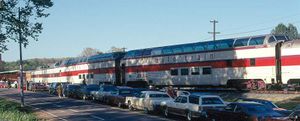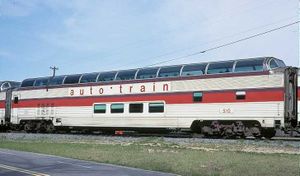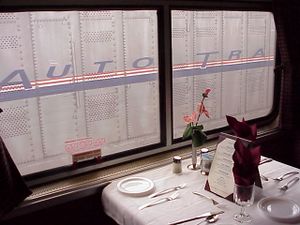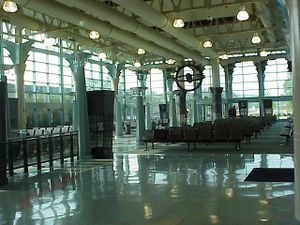Auto Train
Auto Train is an 855-mile-(1376-km-)long scheduled train service for passengers and their automobiles, operated by Amtrak between Lorton, Virginia (near Washington, D.C.) and Sanford, Florida (near Orlando). Although there are similar services around the world, the Auto Train is the only one of its kind in the United States. Specialized equipment enables customers to take along their automobile, van, sport utility vehicle, motorcycle, small trailer, and/or jet-ski as they travel up or down the East Coast. Passengers ride in either wide coach seats or private sleeping car rooms while their vehicles are safely carried in enclosed automobile-carrying freight cars, called autoracks. The train also includes lounge cars and dining cars. The Auto Train service offers its passengers dual benefits: they avoid the long drive on busy Interstate 95 in Virginia, North Carolina, South Carolina, Georgia, and Florida, and instead of the expense and unfamiliarity of a rental car they have the convenience of the use of their own vehicle upon arrival.
The service operates as train 53 southbound and 52 northbound, making no station stops between its terminals at Lorton, Virginia and Sanford, Florida.
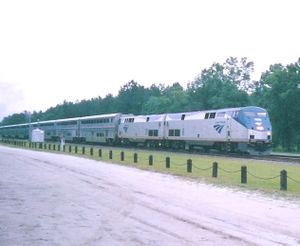
Contents
History: Auto-Train Corporation
The predecessor to Amtrak's Auto Train was the Auto-Train of the Auto-Train Corporation, a public stock corporation founded in 1971 by Eugene K. Garfield. The company used its own locomotives, passenger railcars, autoracks, and cabooses, and used the tracks of the Richmond, Fredericksburg & Potomac (RF&P) and Seaboard Coast Line (SCL) railroads from Lorton, Virginia to Sanford, Florida.
Locomotives and railcars
The Auto-Train Corporation acquired a fleet of thirteen General Electric U36B diesel-electric locomotives. These were very similar to ones used by Seaboard Coast Line Railroad, the host railroad for most of the route's length. The passenger railcars, including coaches, dining cars, sleeping cars, and dome cars, were acquired from various major railroads, including Santa Fe, Union Pacific, and Western Pacific. The Auto-Train's first autoracks were 75-foot-long bilevel models with end doors, carrying eight automobiles each. The cars had originally been owned by Canadian National Railway (CN), the railroad that had pioneered the use of autoracks in the North American freight rail industry beginning in late 1957. The bilevel autoracks were augmented by trilevel ones that were purchased new in 1976.
Since the form and function of the autoracks went far beyond the form and function of baggage cars on an ordinary passenger train, the Auto-Train, like the Amtrak Auto Train of today, can be considered to have been not a pure passenger train but rather a mixed train, meaning one that includes both passenger and freight railcars. Like many mixed trains of the time, but unlike virtually all pure passenger trains of any era, the Auto-Train included a caboose at the end. Like the rest of the equipment, the cabooses were painted in a red, white, and purple color scheme.
A typical Auto-Train was made up of 30 to 64 cars pulled by two or three locomotives.
Business success and failure
The Auto-Train began operations on December 6, 1971. The service enjoyed remarkable success with travelers, and reported profits for the first few years. Before long, the Auto-Train Corporation's ambitious leadership was looking to expand into other markets. A second service, from Louisville, Kentucky to Sanford, was inaugurated in May 1974. It operated only until September 1977, however, reportedly having lost millions of dollars. Two Auto-Train derailments in 1976 and a major derailment in 1978 disrupted service, and cost the company more than $6 million in lost revenue. Debts accumulated, including millions in taxes, leading to cutbacks in maintenance that slowed operations. Eventually the company was forced into bankruptcy; and though the Auto-Train retained much of its popularity to the end, it terminated its services in late April 1981.
Several smaller companies scrambled to pick up the Auto-Train's former customers. A company operating as Auto-Bus carried its customers in buses and their cars in trucks, operating between Pennsylvania and Florida. Another company, Autolog Corporation, offered a service to carry cars by truck between the Northeast and Florida, though not providing transportation for the customers themselves. There were also several companies that hired drivers to take cars individually to their owners' destinations. No one else, however, offered a service quite like that of the Auto-Train, namely transporting a car and its passengers simultaneously to and from Florida.
While their service ultimately failed (as so many American passenger train services had previously failed in the decades prior to Amtrak's startup in 1971), Garfield and Auto-Train Corporation had identified a service that people wanted.
Amtrak steps in to fill the gap
After a period of 22 months without service, the service was revived by the National Railroad Passenger Corporation, better known as Amtrak, the corporation that operates most intercity passenger trains in the United States. Amtrak acquired the terminals in Lorton and Sanford and some of the Auto-Train rolling stock. On October 30, 1983, it introduced its new version of the service, under the slightly respelled name Auto Train, on a triweekly basis. Daily service was introduced a year later.
Amtrak continued to use the bilevel and the trilevel autoracks that Auto-Train had used. For passenger equipment, it initially used a mixture of former Auto-Train railcars and midcentury long-distance railcars from Amtrak's general fleet, all rebuilt to Amtrak's "Heritage Fleet" standards. In the mid 1990s, Amtrak replaced all these passenger railcars, which were of the conventional single-level type, with its newer, bilevel Superliner I and II equipment. In current (2006) Amtrak operations, an Auto Train consist is normally made up of two General Electric P42 diesel-electric locomotives and forty or more railcars (passenger and autorack), for a total length of a half-mile or more. The autoracks normally run on the rear. There is no caboose. Amtrak's Auto Train is sometimes said to have the longest consist of any passenger train in the world, although, as mentioned above, it is arguably best regarded as a mixed train rather than as a pure passenger train. Currently, two Auto Train consists are in simultaneous operation each day. At 4:00 p.m., there are departures from both the Lorton and Sanford terminals. Florence, South Carolina is the only scheduled stop on the 855-mile run: at this stop, the train is refueled and serviced and the engine crew and conductors are changed, but no passengers are entrained or detrained. Each train is scheduled to arrive at the other end the next morning at 8:30 a.m., for an endpoint-to-endpoint average speed of about 52 miles per hour.
Today, Amtrak's Auto Train carries about 200,000 passengers each year. It operates on the same route it and its predecessor have always used, the route now being owned by CSX Transportation. The train is notable, especially within the Amtrak system, for the high quality of its equipment and of its customer service. Grossing about $50 million annually,[citation needed] it is considered Amtrak's best-paying train in terms of income in comparison with operating expenses.
Lorton Terminal
Lorton, Virginia is about a half-hour drive south of Washington, D.C., just off Interstate 95. Amtrak's new Lorton terminal opened in early 2000, and features a large, modern waiting area with high glass walls. The station was designed by architect Hanny Hassan. The suspended sculpture in the lobby was designed by Patrick Sheridan. Outside the waiting room are the tracks where passenger cars are set out for boarding. The platform is 1,480 feet (about 3/10 of a mile) long.
Sanford Terminal
The Sanford Auto Train terminal is about a half-hour drive north of Orlando. It is an older and smaller facility than the terminal at Lorton. Currently, the Auto Train loads its passengers on two tracks in Sanford, as no one track is long enough to accommodate all the passenger railcars. Amtrak and the State of Florida are working on plans to replace the facility in Sanford with a new terminal that can accommodate large numbers of passengers more comfortably.
Other Auto Train-type services
A North American predecessor to the original Auto-Train was a service run by the Canadian National Railway (CN) that allowed passengers to bring their automobiles along on selected passenger trains. This service proved unsuccessful.
First Great Western in the United Kingdom opererated the Motorail service between London Paddington Station and Penzance until September 2005.
In Germany, DB AutoZug (website) has services from sixteen stations to cities in France, Italy, Austria, and Croatia. These are very popular, with 200,000 automobiles transported yearly and half a million passengers. In 2005, DB AutoZug celebrated 75 years of automobile-and-person-carrying trains.
In France, the SNCF's Auto/train (English: Auto-Train) service (website) comprises several overnight automobile-carrying trains throughout France, with some service to neighboring countries as well. In the past, all of the Auto/trains also carried sleeping cars. Many no longer allow passengers to travel on the same train as their automobiles. Typically, passengers drop off their car any time during the day and then use a separate train to reach their destination, where they can pick up the car any time the following day. The hub of the Auto/train route system is in Paris at the Gare de Bercy. Three additional cities, namely Avignon, Narbonne, and Fréjus-St-Raphaël, also have specialized stations for car-carrying service; in other cities the service is operated from a normal passenger facility. The automobiles are carried in open railcars, and for that reason the SNCF offers passengers a free car wash in the arrival city.
In Austria, several of the regular day and night trains of the Österreichische Bundesbahnen include automobile transport cars.
In Finland, VR (website) has a popular automobile-carrying service on its night trains between the south and the north; the service transports 35,000 automobiles a year. VR recently bought 15 new auto carriers for €8 million.
In Chile, EFE (Empresa de los Ferrocarriles del Estado) operates a service called Autotren (website) between Santiago and Temuco.
In Australia, some autoracks are carried by the Indian Pacific cross-country train between Sydney and Perth.
See also
External links
| Wikimedia Commons has media related to: Auto Train (Amtrak) |
- Amtrak's page on the Auto Train
- The official Amtrak website
- Trainweb site with thousands of photos and links to other rail-related sites
- Bill's Railroad Empire--the original Auto-Train page N-scale modeling
- George Elwood's Fallen Flags site, original Auto-Train pages Lots of locomotive and rolling stock photos
- Transcribed text of an Auto-Train Corporation brochure (described as a "1971 brochure", although it must actually be from the period 1974-77), including information on the short-lived Louisville-to-Sanford Auto-Train route
- A Yahoo group for Auto Train enthusiasts
- Diesel shop rail photo site Photo of Auto-Train diesel-electric locomotive when almost new
- Photos and data, Amtrak autoracks
- Orlando Sentinel newspaper article about Auto-Train Corporation and Amtrak's Auto Train replacement
- Motorail trains in Europe
- Autotren in Chile
